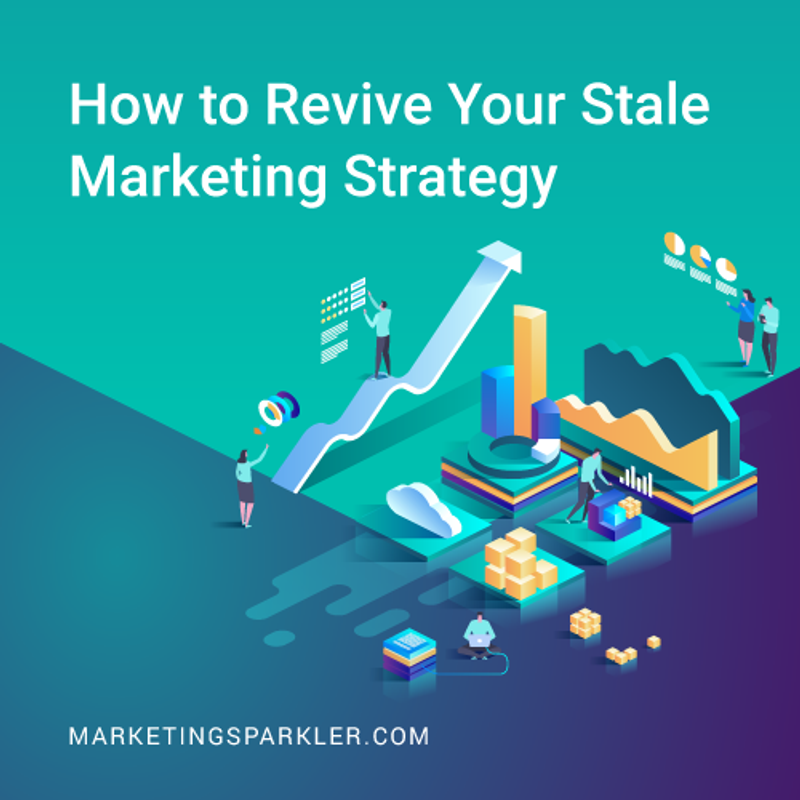When you invest a lot of time and resources into a specific marketing strategy, it can be hard to move away from it later, even if the methods have grown stale. Even more so for a small business with extremely limited resources to begin with. To make matters worse, the entire marketing industry is constantly changing and evolving, with so many trends that come and go.
Sticking with what works makes sense, but it’s not necessarily effective in marketing. Sticking with what isn’t working, doesn’t make sense at all. That means, it’s probably time for an adjustment, but how should you go about it?
How To Revive Your Stale Marketing Strategy
What should you be focusing on, and how do you know what to revise, what to keep, and what to toss out entirely?
1. Grade Everything
If you’ve been doing something for a while, you have the metrics behind its success. Use a grading system to determine how well a strategy or process is working. Go from channel to channel, including social media, and grade your active campaigns. You can use a 1 to 10 scale, or a letter grading system, it doesn’t matter.
Toss out anything that doesn’t earn top marks. Anything below an A should at least be revised, and anything below a B should be discarded.
It’s up to you to establish that standard for grading, and what constitutes high marks. But some things you should look at include audience engagement, views, clicks, bounce rates, conversion rates, and so on.
2. Define Your Niche
Unfortunately, the term “niche” is a buzz phrase that’s thrown around often in marketing. Without getting too into the weeds, a niche is essentially a small group or focus, and in this case, the idea is to define who your actual audience is. Don’t try to attract a broad audience across several time zones, markets, ages, and more. Find the ideal customer, or rather the real people who are using your products and services — that’s your niche and who you need to be marketing to.
Why does this matter when refreshing a stale marketing campaign? It will help you optimize and hone your messaging, media, and content for the right people. Stagnant campaigns tend to balloon and lose more and more focus over time. It’s part of the reason why they become so ineffective. Even if you’ve done this exercise before, return to it.
Small businesses don’t have the resources to focus on a large audience, either, and even a small audience will naturally scale up over time.
How can you begin to define your niche?
-
- Look at your specialized service or products and why customers use them.
- Collect feedback from existing customers.
- Build your ideal customer profile.
- Consider what’s worked best for your brand or business.
- Identify customer pain points and problems.
- Conduct testing to confirm the right niche or focus.
These are just a few examples of ways you can discover and define your niche, but it’s not a comprehensive list.
Defining your niche will help you optimize and hone your messaging, media, and content for the right people. Click To Tweet3. Study Your Competition
Once you understand your audience, it’s time to review your competition. What marketing campaigns have they launched, and have those efforts succeeded? What sorts of problems have they run into? Are they also forcing a stagnant strategy, or have they continued to iterate? Is their marketing more, or less successful than yours?
Also consider the markets, niches, and demographics that your rivals are targeting. Are these the same customers you’re after, or do they have slightly different interests? How well are your competitors’ products and services helping them?
This information will be important for, again, optimizing your future campaigns. As with all things in business, you want your marketing efforts to be highly competitive, so they stand on their own well above the crowd.
4. Plan Your Messaging
Every campaign, big or small, needs coherent messaging that spans the length of the event, even across multiple channels or platforms. What are you trying to tell your audience? Why do they care?
It doesn’t matter whether you’re going to be delivering that message through videos, images, podcasts, print ads, you name it! What matters is that the message is instantly recognizable, wherever it is. A great example is Wendy’s “Fresh, Never Frozen,” tagline. Not only do they use it consistently across channels, but it’s a strong element of all their marketing materials including images, videos, commercials, and beyond.
5. Make It Beautiful
We now live in a world where everyone has a smartphone, computer, tablet, and loads of devices. Most importantly, those devices correctly display high-resolution content with gorgeous imagery, sharp edges, and an encapsulating experience. There is absolutely no reason why your marketing materials — in whatever form they exist — are not up to those standards. Design matters, and that’s true of both digital and physical materials.
Did you know, the right gift card images and designs can influence purchasing decisions by up to 69%? People will buy more gift cards from a brand that has a thoughtful, attractive design on the front. Moreover, special print techniques on gift cards can sway purchasing decisions by up to 67%. Those are just gift cards! Imagine how it applies to other marketing materials like print ads, commercials, social media content, and more?
When is the last time you evaluated your marketing materials, both messaging and design? Click To Tweet6. Go Omnichannel
Believe it or not, multichannel and omnichannel are not the same thing. You probably already use multichannel techniques and have for years. It’s merely when you facilitate a marketing campaign across a variety of platforms and channels like mobile, web, social media, print, and more.
So what is omnichannel then?
Omnichannel is when you combine all those active channels to create a single, seamless user experience.
For example, you might start talking to a customer via Twitter, and then move the conversation to a phone call. But the most important element is that everyone discussed carries over, so the customer doesn’t have to repeat themselves, and they aren’t getting the same experience twice. Every customer receives a personalized, seamless interaction regardless of when and where they’re engaging your reps or business.
Omnichannel strategies drive an 80% higher rate of incremental store visits, according to Google. Also, 3X higher effectiveness rates are reported by companies using multi-channel marketing vs. non-integrated campaigns.
If you allowed your marketing campaigns to grow stagnant it means that somewhere, somehow you have been resistant to change. Embrace change and REVIVE your stale marketing strategy! Click To TweetEmbrace Change
At the end of it all, these strategies are moving towards one very specific thing: change. If you allowed your marketing campaigns to grow stagnant it means that somewhere, somehow you’ve been resistant to change. If you hope to revise your strategies and come up with something more engaging and successful, change is necessary.
Learn to embrace change, and create an ever-evolving process to assess, develop, and implement new programs. That is precisely what this guide introduces.
-
- Start by grading your existing strategies, and getting rid of what isn’t working.
- Then, define or redefine your niche and learn more about your target audience.
- Study your competition, and learn what they’re doing right, and wrong.
- Next, plan your messaging for multichannel deployment, with a coherent yet engaging core.
- Work on making your marketing materials beautiful, in whatever form they are. You may or may not need to bring on professional designers and graphic artists for that if you haven’t already.
- Then, finally, deploy using an omnichannel strategy that offers seamless experiences for your potential customers.
At that point, you’ll be well on your way to a modern, successful, and dynamic marketing program.
Ciao,
Miss Kemya




